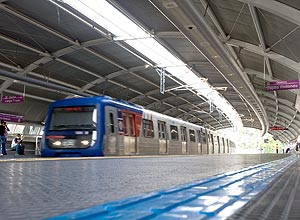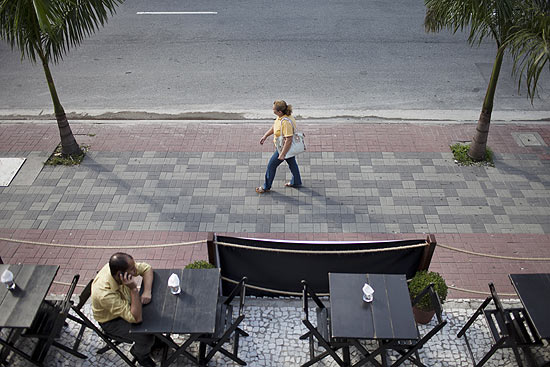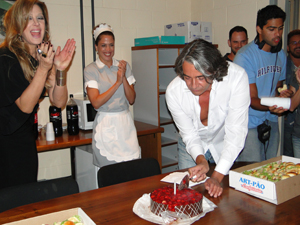Japan’s nuclear power crisis remains unstable and volatile, warn US nuclear experts. They note that accidents at Three Mile Island and Chernobyl grew far worse before being controlled.
Video image taken from NHK shows the Fukushima No.1 nuclear power plant in Japan on Saturday March 12. The ceiling of the building that houses the No. 1 reactor collapsed Saturday, injuring 4 workers, Japan's public broadcaster NHK reported.
Newscom
By Mark Clayton, Staff writer / March 12, 2011
Japan’s unfolding nuclear power crisis remains at an unstable, volatile stage, warn US nuclear experts who, while hopeful, say past nuclear accidents – at Three Mile Island and Chernobyl – grew far worse over several days before being controlled.
Skip to next paragraph Their comments, which came during a Saturday conference call convened by anti-nuclear power groups, were in sharp contrast with reports by the Japanese government which appeared to indicate the main crisis in one of its nuclear reactors was past, although a state of emergency remained in effect for five reactors.
Japanese soldiers were reported pumping seawater into the #1 reactor at the Fukushima I power plant 150 miles north of Tokyo to keep it cool. But one US expert characterized the move as an apparent last-ditch “Hail Mary” effort that could easily fail and be followed by a major radioactive release.
IN PICTURES: Japan's 8.9 earthquake
An enormous explosion Saturday morning – possibly due to a buildup of hydrogen gas – destroyed most of a secondary containment building housing the #1 reactor, but was reported by a government spokesman not to have breached a critical inner steel liner – the reactor’s primary containment vessel.
On Saturday, the Japanese government reported five reactors at two different nuclear power plants – Fukushima I and Fukushima II – to be in a state of emergency following the massive earthquake that hit Japan Friday. A total of 11 of the nation’s 54 reactors shut down following the quake – knocking out about 30 percent of the nation’s power. Still, Japanese officials were matter of fact.
Chief cabinet secretary Yukio Edano told reporters Saturday that radiation around the plant had started to decrease. A “tiny” amount of radiation had leaked earlier in the day when officials attempted to relieve pressure inside the reactor.
“We have confirmed that the walls of this building were what exploded, and not the reactor’s container,” Edano said, adding, “There was no large amount of radiation leakage outside. At this point, there has been no major change to the level of radiation leakage outside, so we'd like everyone to respond calmly.”
Evacuations expanded around reactors
Over the past 24 hours, however, government officials have expanded evacuations around the reactors, and conditions seemed to see-saw wildly at the Fukushima I complex 150 miles north of Tokyo where the #1 and #2 reactors lost their backup cooling systems powered by diesel generators within an hour after the quake.
Pressure was soon reported building in reactor #1, and coolant loss and spiking temperatures were reported in #2. Despite venting of gases at the reactors, the explosion Saturday morning destroyed the containment building of the #1 reactor.
Tokyo Electric Power Co., which operates the plants, reported that an equipment failure had made it "impossible to cool two reactors" at the Fukushima I plant. Air from inside the plant that might contain radioactive materials would be vented from the plant, the company told NHK World late Friday.
Following the Saturday explosion, radiation levels that were reported higher than normal around the site were said by government spokesmen to have declined. Yet the government soon widened an earlier evacuation notice from a 3-kilometer (1.8-mile) radius of the Fukushima I nuclear power plant to 20 kilometers (12.4 miles). An evacuation zone around the Fukushima II plant was set at 10 kilometers. Little is known about conditions at the Fukushima II facility.
Video of the aftermath of the explosion appeared to show that the #1 reactor’s containment building had been destroyed. But the inner containment shell appeared not to have been breached by the explosion, analysts said.
Skip to next paragraph Together, the use of seawater mixed with boric acid – a chemical that absorbs neutrons – and the widened evacuation notice made US experts, several of whom oppose expanded nuclear power in the US, wary of how much progress has been made since direct information on the reactor’s condition was scarce.
The move to use seawater for cooling was clearly a move of “desperation,” said Robert Alvarez, senior scholar at the Institute for Policy Studies, in a press conference of US nuclear experts convened by several anti-nuclear groups. “I would describe this measure as a ‘Hail Mary’ pass. But if they succeed there’s plenty of water in the ocean and if they can pump in the necessary volumes to take away the decay heat they have a chance to stabilize the situation.”
In a General Electric Mark I reactor, the type used in Japan and the United States, the containment building is considered fairly weak and is a secondary type of containment. The primary containment is a steel liner surrounding the reactor core. The critical issue is: Can enough sea water be pumped to cool the #1 reactor core – or will the core melt?
“This type of accident is called a ‘station blackout,’” said Ken Bergeron, a physicist and former Sandia scientist who worked on nuclear reactor accident simulations. With the loss of backup diesel generators to run the primary cooling system, and a secondary backup system powered by batteries, “we’re in uncharted territory … and hoping that all of the barriers to release of radioactivity will not fail.”
Japan’s health ministry was reported to have sent an emergency medical team to the Fukushima I plant to set up a nuclear disaster response center about 5 kilometers from the power plant, Japan Broadcast Corporation’s NHK World website reported.
Questioned raised about US nuclear power
The Japanese accidents appear certain to fuel debate in the US over the safety of domestic power plants from earthquakes and other natural disasters, some experts said. Regulators’ focus in the US would likely fall on Diablo Canyon and San Onofre, two plants in active seismic areas, but might extend to other aging plants now being assessed for permits to extend their operating lives.
Nuclear power advocates at the Nuclear Energy Institute in Washington said the Japanese government appeared to have the situation under control, and they took issue with the idea that history showed nuclear crises growing worse before getting better.
“I was at Three-Mile Island, and the crisis inside the reactor peaked and started to decline later that same day even though the public perception was just the opposite because of poor communication,” says Thomas Kauffman, an NEI spokesman. “We have heard that they are injecting seawater into the reactor, but I don’t know how successful that effort has been and to comment on it would be sheer speculation.”
Nuclear power plants in the US, he added, are each individually designed to withstand the maximum earthquake for that particular region.
“You’ve got to keep in mind, this plant experienced a seismic event it wasn’t built to withstand – and it’s in one of the most seismically active areas in the world,” he says. “The nuclear plants in California that are in active seismic areas have extra design features to help them deal with that activity.”
The Nuclear Regulatory Commission, he noted, would certainly bring any lessons learned from the Japanese experience back to the US.
“They’re going to look at the root causes in Japan and figure out what happened,” Mr. Kauffman says. “If an adjustment needs to be made they’ll be made.”

Sphere: Related Content

![Validate my Atom 1.0 feed [Valid Atom 1.0]](valid-atom.png)






















































 A rua dos Pinheiros, na zona oeste de São Paulo, vai ganhar projeto de revitalização para ficar com características de bulevar. A informação é da coluna Por Aí, publicada todos os sábados no caderno Cotidiano da Folha (
A rua dos Pinheiros, na zona oeste de São Paulo, vai ganhar projeto de revitalização para ficar com características de bulevar. A informação é da coluna Por Aí, publicada todos os sábados no caderno Cotidiano da Folha (




 Maria Adelaide (Foto: TV Globo/João Miguel Júnior)
Maria Adelaide (Foto: TV Globo/João Miguel Júnior) Para autora, Jaque é um dos destaques da novela
Para autora, Jaque é um dos destaques da novela O colaborador Vincent Villari, Mayana Neiva, Christiane Torloni, Maria Adelaide Amaral, Elizângela, Rodrigo Lopez, o diretor Ary Coslov, Daniela Scobar e a figurinista da novela, Marília Carneiro
O colaborador Vincent Villari, Mayana Neiva, Christiane Torloni, Maria Adelaide Amaral, Elizângela, Rodrigo Lopez, o diretor Ary Coslov, Daniela Scobar e a figurinista da novela, Marília Carneiro A autora e seu colaborador também posaram ao lado de Rafael Cardoso
A autora e seu colaborador também posaram ao lado de Rafael Cardoso Felizes, companheiros de elenco, diretor e integrantes da produção comemoram o aniversário de Alexandre
Felizes, companheiros de elenco, diretor e integrantes da produção comemoram o aniversário de Alexandre Alexandre parte o bolo e oferece o 1º pedaço a...
Alexandre parte o bolo e oferece o 1º pedaço a... Claudia Raia, que parece não acreditar no presente
Claudia Raia, que parece não acreditar no presente Ari finalmente se declara para Marta
Ari finalmente se declara para Marta Os filhos ficam surpresos com o que veem
Os filhos ficam surpresos com o que veem Al-Jazeera says a cameraman for the pan-Arab satellite station has been killed near the eastern Libyan city of Benghazi.
Al-Jazeera says a cameraman for the pan-Arab satellite station has been killed near the eastern Libyan city of Benghazi.
